| |
CD4 Count Based ADAP Eligibility Proposed
|
| |
| |
"Optimizing Resource Allocation in United States AIDS Drug Assistance Programs"
Clinical Infectious Diseases Nov 15, 2006;43:1357-1364
Benjamin P. Linas,1,2,3 Hui Zheng,1,3 Elena Losina,4,5 Annette Rockwell,6 Rochelle P. Walensky,1,2,3 Kevin Cranston,6 and Kenneth A. Freedberg1,2,3,4,5
Divisions of 1General Medicine and 2Infectious Diseases and 3The Harvard Center for AIDS Research, Massachusetts General Hospital and Harvard Medical School, Departments of 4Biostatistics and 5Epidemiology, Boston University School of Public Health, and 6Massachusetts Department of Public Health AIDS Bureau, Boston, Massachusetts
(See the editorial commentary by Mike Saag in the next email)
ABSTRACT
Background. US acquired immunodeficiency syndrome (AIDS) Drug Assistance programs (ADAPs) provide medications to low-income patients with human immunodeficiency virus (HIV) infection/AIDS. Nationally, ADAPs are in a fiscal crisis. Many states have instituted waiting lists, often serving clients on a first-come, first-served basis. We hypothesized that CD4 cell count-based ADAP eligibility would improve ADAP outcomes, allowing them to serve more-diverse patient populations and to prioritize persons who are at greatest risk of HIV-related mortality.
Methods. We used Massachusetts ADAP administrative data to create a retrospective cohort of Massachusetts ADAP clients from fiscal year 2003. We then used a model-based analysis to apply potential eligibility criteria for a limited program and to compare characteristics of patients included under CD4 cell count-based and first-come, first-served eligibility criteria.
Results.
In fiscal year 2003, Massachusetts ADAPs served 3560 clients at a direct cost of $10.3 million. With use of CD4 cell count-based eligibility (with an eligibility criterion of a current or nadir CD4 cell count <350 cells/uL), it would have served 2253 clients (37% fewer than in fiscal year 2003) and appreciated savings of $2.7 million. Given the same budget constraint and using first-come, first-served eligibility, Massachusetts ADAPs would have served 2406 clients (32% fewer than in fiscal year 2003).
The first-come, first-served approach would have excluded patients with median CD4 cell count of 257 cells/uL (interquartile range, 124-377 cells/uL) in favor of serving patients with median CD4 cell count of 659 cells/uL (interquartile range, 511-841 cells/uL).
In addition, a CD4 cell count-based scheme would have served a greater proportion of nonwhite individuals (65% vs. 55%; P < .0001), non-English speakers (24% vs. 19%; P = .03), and unemployed people (69% vs. 61%; P = .0009), compared with the population that would have been served by a first-come, first-served policy.
Conclusions. With limited resources, ADAPs will serve more-diverse populations and patients with significantly more advanced HIV disease by using CD4 cell count-based enrollment criteria rather than a first-come, first-served approach.
INTRODUCTION
AIDS Drug Assistance programs (ADAPs) provide medications for low-income patients with HIV infection/AIDS in the United States. Each state administers its own ADAPs funded primarily by the federal Ryan White Care Act [1]. In June 2005, ADAPs provided HIV medications to >94,000 patients, 58% of whom were Hispanic or black, and 50% of whom lived at or below the federal poverty level [1].
Combination antiretroviral therapy has increased both the life expectancy and cost of care for people living with HIV infection [2, 3]. As a result, ADAPs face budget shortfalls [1, 4]. As of February 2006, a total of 25 states had either initiated or anticipated initiating cost-containment measures for the coming fiscal year [5]. Faced with increasing costs, most ADAPs have considered reducing the formulary, changing eligibility rules, and negotiating price discounts, but no standardized approach exists [4]. After negotiating price reductions, many states limit program eligibility to meet constraints [1, 4].
Even after limiting eligibility, some states cannot meet the demand for treatment, and they start waiting lists [1, 4]. Many states accept patients from the waiting list on a first-come, first-served basis, whereas other states consider medical need [4]. The first-come, first-served approach is administratively expedient, but it may exclude patients with advanced HIV disease in favor of patients at a lower risk of mortality. Furthermore, because nonwhite persons in the United States tend to learn of their HIV infection later in the course of disease than do white persons, the first-come, first-served approach may limit access to care for historically underserved populations [6-12].
We used the Massachusetts ADAP administrative data set to estimate and compare the characteristics of Massachusetts ADAP enrollees, with resources prioritized either on the basis of CD4 cell count or on a first-come, first-served basis. We hypothesized that, at any budget constraint, CD4 cell count-based eligibility would serve more-diverse patient populations with significantly lower CD4 cell counts than would a first-come, first-served approach.
METHODS
Study Design
We used the Massachusetts ADAP administrative data set to create a retrospective cohort of clients in the Massachusetts ADAP in fiscal year 2003 (FY2003). We then used a model-based analysis to generate cohorts of included patients and to estimate the clinical and demographic characteristics of ADAP enrollees had Massachusetts implemented either CD4 cell count-based or first-come, first-served eligibility criteria in FY2003.
Cohort
The assembled data set included CD4 cell count history, date of birth, sex, race, primary language, employment status, and number of dependents. It also included reimbursement data for prescriptions filled while the applicant was enrolled in the ADAP. We excluded clients who had no CD4 cell count reported in the data set.
Model Details
Generating a cohort of individuals included under CD4 cell count-based eligibility. Because treatment recommendations suggest initiation of antiretroviral therapy at a CD4 cell count of 200-350 cells/uL or if the nadir CD4 cell count is <200 cells/L [13], we began with the criterion that any applicant with a current or nadir CD4 cell count <350 cells/uL would be eligible for ADAP. We applied this CD4 cell count-based eligibility criterion to generate the cohort of included applicants, and we used reimbursement data to determine the cost of treating each person in FY2003. We report the sum of these individual costs as the estimated FY2003 ADAP budget under the proposed CD4 cell count-based eligibility scheme.
Generating a cohort of individuals included under first-come, first-served eligibility. We then listed all FY2003 ADAP applicants in the order in which they applied to the program, and we "accepted" applicants on a first-come, first-served basis, using reimbursement data to keep a running tally of costs. When the total budget needed to treat the included cohort equaled the budget calculated for the CD4 cell count-based approach, we stopped "enrolling" applicants.
The process described thus generated 2 cohorts: one consisting of patients who would have been included under the proposed CD4 cell count-based eligibility criterion, and the other consisting of applicants who, given the identical budget constraint, would have been accepted on a first-come, first-served basis.
Comparing clinical and demographic characteristics. We then compared the median current and nadir CD4 cell counts and the demographic characteristics for both groups. Many individuals were included in ADAPs under both eligibility criteria. Because of this overlap in comparison groups, we report observed values and interquartile ranges (IQRs), but there are no tests of statistical significance for this portion of the analysis.
We next focused on patients who were included under one eligibility scheme but excluded under the other. These patients represent the applicants whose clinical outcomes would have been most directly affected by the choice of an eligibility criterion. Furthermore, because the groups are mutually exclusive, they are more easily compared. We compared the current and nadir CD4 cell counts in each group, and we used X2 analysis to compare demographic characteristics.
Consideration of alternate eligibility criteria. We then repeated the process above using a variety of CD4 cell count-based criteria, which represented a spectrum of ADAP eligibility (table 1). We report the estimated number of persons served and the total budget under each of the potential eligibility standards.
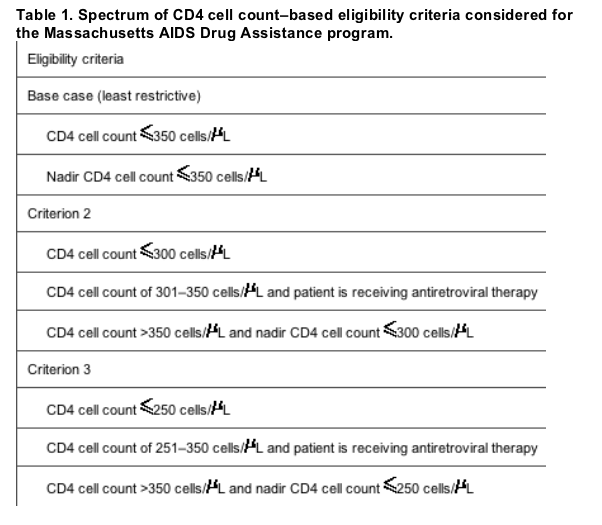
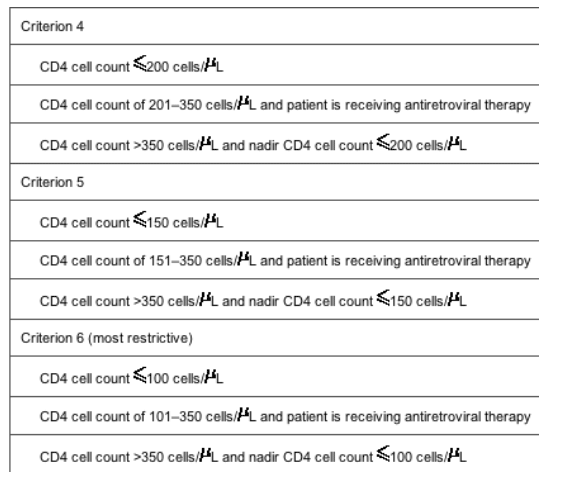
Simulating states with more-severe budget constrains than Massachusetts. States vary in their per-capita ADAP spending, and findings for Massachusetts may not reflect those for all states [1, 4]. Several states have already implemented cost-control measures but still cannot meet the demand for treatment [1]. To reflect such conditions, we modeled a scenario in which, despite limitation of eligibility to persons with a current or nadir CD4 cell count <200 cells/uL, Massachusetts was unable to meet ADAP demand and needed to consider additional restrictions. We first limited the data set to persons with a current or nadir CD4 cell count <200 cells/uL, and we then used the method described above to compare outcomes associated with use of still more-restrictive CD4 cell count-based eligibility (i.e., the patient was eligible if the current or nadir CD4 cell count was <100 cells/uL) with a first-come, first-served approach involving persons with a CD4 cell count <200 cells/uL.
Assessing the impact of missing nadir CD4 cell count data on the conclusions. We estimated the impact of missing data on the nadir CD4 cell count on the conclusions by assuming that any patient with only 1 CD4 cell count in the data set had missing CD4 cell count data that could have affected ADAP eligibility. We repeated each of the analyses described above, "accepting" into the ADAP all patients with only 1 CD4 cell count in the data set. This method likely included some patients who should have been excluded from the CD4 cell count-based approach; it is a conservative estimate of the impact of missing data on nadir CD4 cell count.
RESULTS
Data were available for 3914 individuals in the FY2003 Massachusetts ADAP data set. Of these, 3560 (91%) had adequate CD4 cell count data to make an eligibility determination for inclusion in the analysis. The direct cost of treating these 3560 individuals in FY2003 was $10.3 million.
We first considered the base case CD4 cell count criterion that would have made any applicant with current or nadir CD4 cell count <350 cells/uL eligible for ADAP. Under this eligibility scheme, the program would have served 2253 clients (37% fewer than were served in FY2003), with a savings of $2.7 million (26% savings over the FY2003 cost for an unrestricted ADAP). The median CD4 cell count would have been 282 cells/uL (IQR, 153-423 cells/L) (table 2). Given the same budget constraint (savings of $2.7 million), had Massachusetts ADAP accepted applicants on a first-come, first-served basis, the program would have served 2406 clients (32% fewer than were served in FY2003), with a median CD4 cell count of 411 cells/uL (IQR, 243-627 cells/uL) (table 2).
We then analyzed the applicants who would have been accepted to a limited ADAP program under only 1 of these eligibility schemes. Of the 3560 individuals in the data set, 1685 (47%) would have been accepted under only 1 eligibility scheme. Had ADAP accepted applicants on a first-come, first-served basis, the program would have excluded patients with a median CD4 cell count of 257 cells/L (IQR, 124-377 cells/uL) and median nadir CD4 cell count of 208 cells/L (IQR, 87-312 cells/uL; 47% had Centers for Disease Control and Prevention [CDC]-defined AIDS), in favor of serving a group with a median CD4 cell count of 659 cells/uL (IQR, 511-841 cells/uL) and a nadir CD4 cell count of 507 cells/uL (IQR, 416-657 cells/uL; 0% had CDC-defined AIDS) (figure 1). Compared with the first-come, first-served approach, the CD4 cell count-based scheme would have served a greater proportion of women (28% vs. 21%; P = .002), nonwhite individuals (65% vs. 55%; P < .0001), non-English speakers (24% vs. 19%; P = .03), and unemployed persons (69% vs. 61%; P = .0009) (table 3).
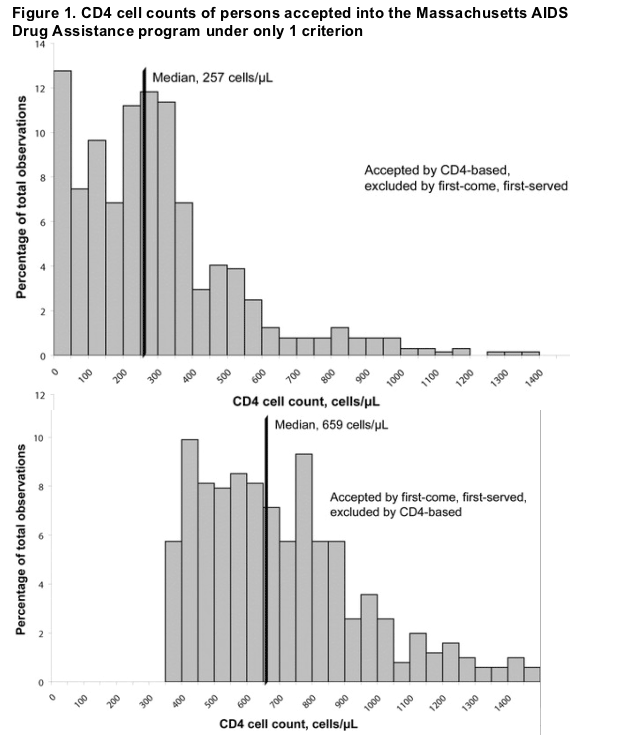
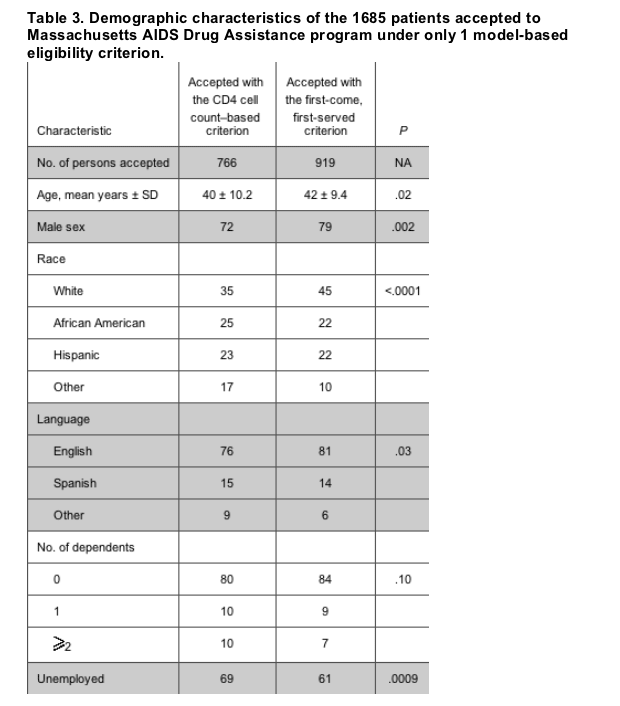
We then repeated the analysis using a series of increasingly restrictive CD4 cell count-based eligibility schemes (table 1). As the eligibility threshold became increasingly restrictive, costs decreased such that, by adjusting the CD4 cell count-based eligibility criterion, the ADAP could meet the more-severe budget constraints. Of note, using a CD4 cell count-based eligibility scheme concordant with published US HIV treatment guidelines [4], the Massachusetts ADAP would have been able to serve all patients with current or nadir CD4 cell counts <350 cells/uL and would have still recorded cost savings of 26% (figure 2). Under each of the eligibility standards tested, the first-come, first-served approach would have served more applicants than the CD4 cell count-based approach, but it would have excluded patients with CD4 cell counts of 232-257 cells/uL in favor of a cohort with CD4 cell counts of 556-659 cells/uL (table 4).
Figure 2. AIDS Drug Assistance program (ADAP) costs and savings, by CD4 cell count-based eligibility criteria. Criteria are defined as minimum to maximum CD4 cell count. Applicants with current or nadir CD4 cell counts less than the minimum level are eligible under the CD4 cell count-based criterion. Applicants whose current CD4 cell counts are between the minimum and maximum and who are taking antiretroviral medications are eligible under the CD4 cell count-based criterion (see Methods for details).
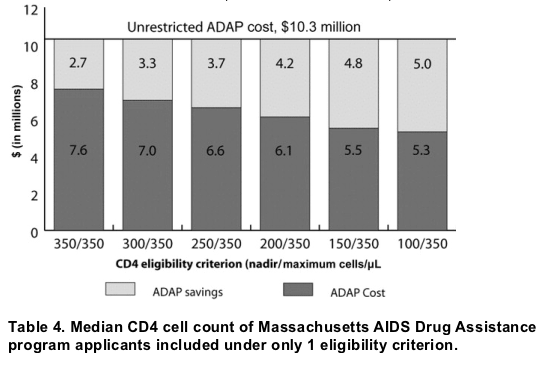
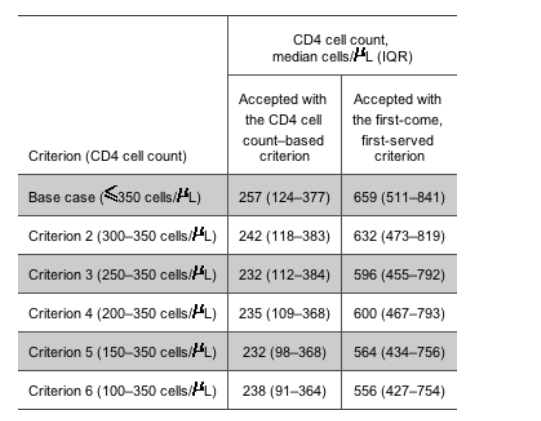
Compared with the first-come, first-served approach, all of the tested CD4 cell count-based approaches served a greater proportion of nonwhite individuals and non-English speakers. All of the CD4 cell count-based criteria would have led the ADAP to serve a greater proportion of unemployed persons (P < .05 for 4 criteria; P = .12 for 2 criteria). Although the base case CD4 cell count eligibility scheme resulted in a greater proportion of women being served, compared with the proportion of women served by the first-come, first-served policy (28% vs. 21%; P = .002), this difference was not statistically significant for all CD4 cell count-based eligibility criteria.
We next simulated a situation in which Massachusetts had already limited ADAP eligibility to those with current or nadir CD4 cell counts <200 cells/L but was unable to meet demand. There were 1266 individuals with current or nadir CD4 cell counts <200 cells/L. The direct cost of treating all of them would have been $4.8 million. Had Massachusetts further limited eligibility on the basis of the CD4 cell count (with persons eligible if their current or nadir CD4 cell count was <100 cells/uL), the ADAP would have served 867 people at a cost of $3.5 million. Given the identical budget constraint ($3.5 million), the first-come, first-served approach would have served 862 people. With this very constrained budget, the first-come, first-served approach would have excluded patients with a median nadir CD4 cell count of 49 cells/uL in favor of serving patients with a median nadir CD4 cell count of 156 cells/uL. Compared with the first-come, first-served approach, the CD4 cell count-based approach would have continued to serve a greater proportion of women (27% vs. 20%; P = .05) and nonwhite patients (69% vs. 66%; P = .02).
Finally, we estimated the impact of missing nadir CD4 cell count data on the conclusions. Acceptance of all patients with only 1 CD4 cell count in the data set had little impact on the results. Under base case assumptions (i.e., patients were eligible if the current or nadir CD4 cell count was <350 cells/L), the first-come, first-served approach continued to exclude patients with a median CD4 cell count of 353 cells/uL in favor of treating those with a median CD4 cell count of 700 cells/uL. Again, the CD4 cell count-based approach served a greater proportion of women (28% vs. 18%; P = .0005), nonwhite patients (64% vs. 54%; P = .01), and non-English speakers (25% vs. 17%; P = .003).
AUTHOR DISCUSSION
This analysis provides evidence that CD4 cell count-based eligibility criteria will allow ADAPs to simultaneously control costs, prioritize the sickest patients, and address health care disparities for minority populations. Under each of the eligibility standards tested, the CD4 cell count-based approach prioritized patients with CD4 cell counts near or less than 200 cells/uL and served a greater proportion of nonwhite individuals, non-English speakers, and unemployed persons-people who have historically had reduced access to HIV care [6-11]. Given that there have been recent calls to standardize ADAP coverage [4, 14, 15], our findings raise the question of whether ADAPs should abandon the first-come, first-served approach.
One reason to favor a first-come, first-served approach is that doing so serves a greater number of people than does the CD4 cell count-based approach. To the extent that the additional patients served by the first-come, first-served approach are at elevated HIV-related mortality risk, the first-come, first-served approach might be associated with decreased HIV-related mortality, compared with the CD4 cell count-based approach. It is unlikely, however, that serving the larger population with a first-come, first-served approach would be associated with improved mortality. Under each of the criteria tested, the first-come, first-served approach excluded patients with CD4 cell counts near 200 cells/uL in favor of serving a larger group with CD4 cell counts >500 cells/uL. These patients with higher CD4 cell counts have low expected HIV-related mortality rates in the upcoming year [16, 17]; enrolling them in an ADAP, therefore, likely does not prevent HIV-related deaths. If one seeks to minimize mortality, the priority should be to serve patients with low CD4 cell counts; these are the patients with an elevated 1-year mortality risk [16, 17]-mortality that can most often be prevented by providing access to medications through a CD4 cell count-based approach.
ADAP is able to serve a greater number of patients on a first-come, first-served basis because the first-come, first-served approach serves a greater proportion of patients who do not take antiretroviral therapy. These patients are enrolled in ADAP because it helps them pay for other medications. States whose ADAPs cover only antiretroviral therapy would likely not see such a difference in the number of persons served. Indeed, when we limited the data set to only patients with current or nadir CD4 cell counts 200 cells/L, the 2 approaches served approximately the same number of patients, although the CD4 cell count-based strategy continued to prioritize the patients with the most-advanced disease and members of underserved populations.
Another reason to implement a first-come, first-served approach is that it provides a sense of fairness. To the extent that the order in which patients apply to ADAP is random, first-come, first-served is a lottery system. The order in which individuals apply to ADAP, however, may not be random. Nonwhite persons in the United States are likely to have HIV infection diagnosed later in the course of disease than are white persons [6, 12, 18], and they are less likely to start antiretroviral therapy [7, 8, 11, 19, 20]. Delays in diagnosis and treatment lead directly to delays in applying to ADAP and increase the time that an individual lives with HIV infection before being accepted to the program. In contrast, the CD4 cell count-based approach would likely decrease HIV-related mortality at the same time that it served a significantly greater number of nonwhite individuals, non-English speakers, and unemployed persons.
Our results demonstrate that, even under very restrictive budgets, CD4 cell count-based eligibility is likely more efficient and more equitable than a first-come, first-served approach. In other areas of medicine, limited resources are distributed on the basis of medical need. Transplant organs are allocated to patients who need them the most [21], and during shortages, vaccines are given first to those at highest risk of acquiring infection [22]. Indeed, when there is agreement that resources should be prioritized to persons who stand to benefit most, a first-come, first-served approach often generates unjust outcomes [23-25].
It is important to note, however, that policies limiting access to antiretroviral therapy for patients with CD4 cell counts <350 cells/L, although more efficient and equitable than the first-come, first-served approach, may be less efficient than improving ADAP funding, such that all persons who meet guidelines for antiretroviral therapy receive therapy. Antiretroviral therapy has been shown to be a cost-effective intervention at CD4 cell counts <350 cells/L [2]. Provision of adequate funding to ADAPs, therefore, likely remains the optimal resource allocation. Given the reality of current ADAP funding, however, many states administer their ADAP under tight constraints. Between the choices of first-come, first-served eligibility and CD4 cell count-based eligibility, these results demonstrate that the CD4 cell count-based approach has superior efficiency and equity.
There are limitations to this analysis. First, we based our conclusions on data from a single state and used them as a model for a discussion of ADAPs nationwide. There is substantial variation by state in per capita ADAP expenditures [1, 4, 26]. Although our estimates of the absolute savings and numbers served are thus not fully generalizable, the relative findings-comparisons of CD4 cell counts and demographic characteristics-are. Our results do not suggest that all states could control ADAP costs while serving all patients with a CD4 cell count <350 cells/L. Rather, they indicate that, given any budget constraint, the CD4 cell count-based approach will likely lead to decreased HIV-related mortality while simultaneously improving access to care for historically underserved populations.
Because this was a cross-sectional analysis, we could not make quantitative mortality estimates for each eligibility scheme. The data suggest, however, that such estimates are not necessary to make a policy choice between the first-come, first-served approach and the CD4 cell count-based approach. Under identical budget constraints, the first-come, first-served approach consistently excluded patients with low CD4 cell counts, whereas the CD4 cell count-based approach consistently prioritized them. The CD4 cell count-based approach would thus likely lead to fewer HIV-related deaths in the next year than would first-come, first-served eligibility [16, 17, 27]. Given that the CD4 cell count-based approach has lower expected mortality than the first-come, first-served approach, with identical cost, the former should be preferred.
In addition, because this was a cross-sectional analysis, we could not model inefficiencies resulting from the transition to a CD4 cell count-based eligibility scheme. Because the transition period would be short, however, it would have little impact on long-term results. Furthermore, the primary conclusion of the analysis-that CD4 cell count-based eligibility is likely to be more efficient and more equitable than the first-come, first-served approach-does not depend on the savings recorded during the transition period.
Next, because the data set does not include CD4 cell count data prior to a patient's enrollment in the ADAP, it is impossible to assess the completeness of the data on the nadir CD4 cell count. To assess the impact of missing data on the results, we performed several sensitivity analyses on the impact of missing nadir CD4 cell counts; all analyses confirmed the base-case scenario findings.
Finally, current antiretroviral therapy guidelines suggest treating patients with symptomatic HIV infection, regardless of their CD4 cell count [13]. We could not simulate an ADAP policy that included persons with a high CD4 cell count and symptomatic infection. However, because <10% of patients with CD4 cell counts >350 cells/L have symptomatic disease, their impact on the conclusions would be minimal [28].
ADAPs around the country face fiscal insolvency, and current budget forecasts suggest that programs will likely face the need to reduce services in coming years. Although the Medicare Part D program will provide some relief for patients enrolled in ADAPs who are eligible for Medicare, only 13% of ADAP clients qualify for Medicare [29]. In planning for reductions, it is important to consider both efficacy concerns and considerations of fair access to care to help the worst-off persons in society. ADAPs can do both most successfully by basing eligibility on the stage of disease.
|
|
| |
| |
|
|
|